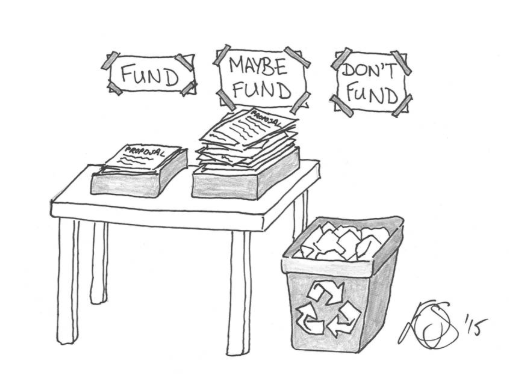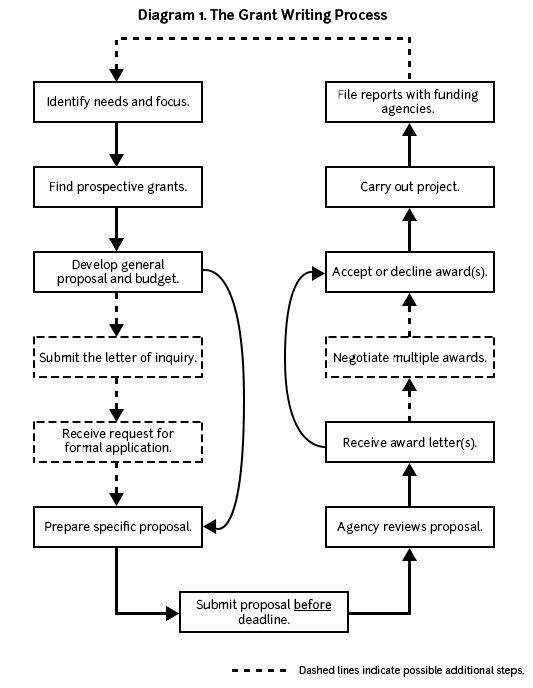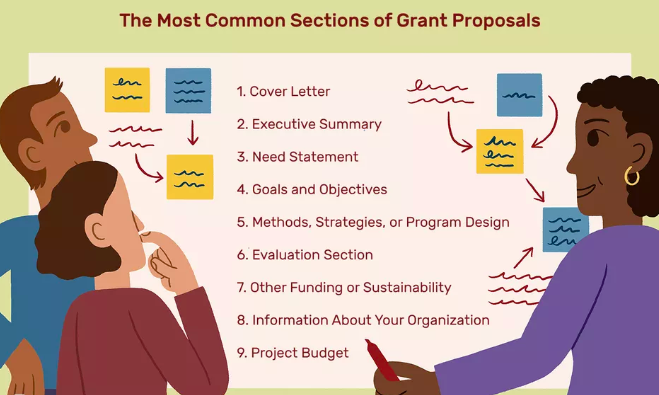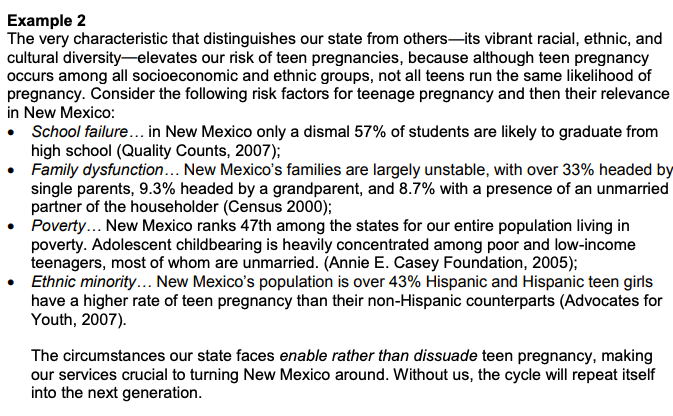Table of Contents
“That proposal is probably going to get rejected.”
Tough, but true.
A hard part of writing nonprofit grant proposals is that the success rate for winning grants is only 10% to 20%.

If you do not watch out, the grant proposal you are laboring over could very well end up in that trash bucket!
Now let me tell you a secret:
Faithfully following grant proposal guidelines alone will not win you the grant.
It is a good start, yes. But you need more.
A winning proposal stands out from the rest. It decides for the reviewer and makes him pick your project. If all you are doing is sticking to the grant guidelines, your proposal is just one more to add to the reject pile.
Writing a winning nonprofit grant proposal means being aware of certain unsaid clues. That is where this post will help.
I will walk you through the unspoken needs and norms, as well as the explicit rules and criteria of the review process, so that your proposal has a higher chance of winning.
Writing a nonprofit grant proposal that wins
Here is a typical cycle of a grant application:

What should jump out at you right now is that the grant application process is not linear but cyclical. It continues even after the grant is awarded (to make way for future donations).
This cyclical aspect of the process should be reflected in your writing. That is, you should articulate the immediate impact of the project. Explain how sustainable it is and also the kind of long-term impact it can have.
This detailed write-up also educates the funders about the problems unique to your community. So, the next time you approach them for a grant (maybe for the same project), it can get funded easier.
Read Also: Fantastic Nonprofit Grants And Where To Find Them.
Now, let’s talk about the overt criteria that you can follow for your grant process in 3 steps:
Step 1: Identify needs and focus
Step 2. Grant Prospect research
Step 3. Writing the grant proposal
Let’s explore.
Step 1. Identify needs and focus
Every successful grant proposal stems from a substantial project that genuinely helps the community. To develop such a project, you first need to identify the gaps that exist currently in the community.
Such an exercise, called the community needs assessment program, uses outreach strategies, which is crucial for effective nonprofit grant writing.
The outreach strategy should tell you:
- What are the current problems within the community
- Which one should you focus on immediately
- How can your nonprofit solve that problem
Based on your findings, you will develop a project plan. This project plan will give you a clear idea of the costs involved and the funds you need to accomplish the goal.
For instance, you would find that you can get better results if you can increase the efficiency of your team. In such a case, you will apply for a capacity-building grant.
Or, if you see in the project plan that the software you use needs an upgrade, you can apply for an IT grant.
This first step helps you identify which nonprofit grants to apply for and how much money to ask for.
Read Also: How to Build A Stable Nonprofit Fund Development Plan
Step 2. Grant prospect research
Not all grantmakers will fund your project. This is especially true if you are applying for an offbeat grant (like, say, an operating grant).
So, it is crucial to research grant-making organizations and understand:
- What kind of projects have they funded in the past? This will tell you if your project is likely to get funded.
- What are the grantmakers’ funding priorities? This will tell you if your project aligns with the funding organization’s mission. If it does not, your proposal will be rejected.
- How much money did they give away last year? Will they stick to the same number or give more this year? This will show you how much money the organization can bestow.
- What are the grant guidelines? – Do they need a letter of intent and proposal solicited afterward? Or are they open to you directly approaching them with a grant? – It will tell you whether to start with a Letter of Inquiry, a letter proposal, or the actual proposal.
If you are planning to approach the Nestle Foundation for a grant, then this is what would jump out at you:

So you would first work on a letter of intent, and if that succeeds, then write the complete proposal.
Similarly, the guidelines for each grant (sometimes within the same Foundation) can vastly differ from each other. Sticking to these guidelines will ensure that your proposal is not rejected outright.
“You don’t want to be the guy whose proposal was rejected because they didn’t use the correct font that the Foundation specified.”
Ava Rosenblatt, Grant Manager
Quick fact: The most common reasons grants are rejected are improper prospect research, organizations finding that the proposal is outside their funding priorities, or nonprofits not adhering to the grant guidelines. So do not skip this step!
Step 3. Writing the grant proposal
Once you get the all-clear to submit a proposal from the Foundation, the actual writing work starts. If you think your nonprofit does not have the bandwidth and skill set to take this on, you can get help from a professional grant writer.
What is included while writing a nonprofit grant proposal varies? Here are a few general elements that are seen in every grant:

Let us quickly see how best to write each of these elements for your proposal.
Cover letter
A cover letter is the first thing the funding Foundation will read about you. So having a sloppy cover letter would be a big turn-off (that is, it will drastically impair your chances of winning the grant.)
A good cover letter identifies your organization, introduces the project, and also states the amount of money you are requesting. Remember to include the name and contact details of the person within your nonprofit with whom they can get in touch later.
To ensure your cover letter makes a good first impression, always address it to a particular person in the Foundation (Eg. Dear Ms./Mrs./Dr. Smith). The prospect research you have already done would come in handy here.
Keep it brief and professional, and end with a salutation (like ‘yours sincerely’). More importantly, don’t try to write a story or be ‘different’ in your tone. It would probably get rejected.
Pro tip: Expert grant writers suggest that you write the cover letter last—after you have finished the whole proposal. Doing so will give you a better idea of what to say in it.
Executive summary
It is a concise explanation of the community problem and your potential solution. It should give the reader a complete picture of how your organization can help the community.
A grantmaker reads this document right before the actual proposal. So, it is important that you make it as interesting and engaging as possible.
Pro tip: Check the funders’ guidelines to see how long the executive summary has to be. If the length is explicitly stated, do not exceed it (try to be as close to it as possible. As a rule of thumb, this section is not more than 3 or 4 pages long.
The needs statement
Remember the findings of your needs assessment that we discussed? This is where you tell your funders about them.

A needs statement (also called a problem statement) conveys the urgency of the problem you have identified within the society. It motivates the reader to address the issue and explain why he should care.
To convey your point better, do not shy away from using data and statistics. The numbers should support your point, be objective, and still convey how huge the problem statement is.
Here is an example statement as given by the grantmakers United Way:

Notice how each grant writer has clearly articulated 4 different aspects that affect the problem statement (an increase in teen pregnancy). For each point, the writer has used numbers to support his stance.
He also ends by describing the crucial role his nonprofit plays in ending the problem. This tells the reader why they should fund this organization over others.
Pro tip: A good needs statement is written for the intellect and emotions. It should engage the reader, contain hard data, and also a logical argument to make your case.
Read Also: The perfect nonprofit storytelling approach to create effective messaging that drives action
Goals and Objectives
Once the reader is convinced about the problem, he wants to know what solution you can offer. The goals and objectives section helps with that.
Goals are what your project (or nonprofit) can accomplish. Objectives are the measurable changes and impacts you can expect.
For example, your goal can be making clean water accessible to all remote areas in a community. The measurable objectives can be the number of taps or pipes you installed, the number of wells you helped resuscitate, or even the number of locals who attended your awareness rally.
If your project has several goals, remember to link each objective back to the goal.
Pro tip: Make your objectives as specific as possible. “Who directly benefited from this project? What is the time frame of the project? What metrics are you going to measure and how?” are all questions the goals and objectives should answer.
Methods, strategies, or program design
In this section, you walk your reader through exactly how you plan to achieve the goals. Give a detailed description of your methodologies, how you will carry out the program, and who will do it.
For, eg. Explain each activity you have planned and the outcome you can generate. Are you having a rally? A seminar? An awareness program? Who is the target audience for it, and how will it bring you closer to your objective?
Be upfront about any hurdles or roadblocks you expect. Tell your readers how you plan to overcome these hurdles and what skillsets your nonprofit has to tackle these challenges.
Pro tip: The program budget is sometimes included in this section. Please return to the grant guidelines to see where you are asked to put it. If the grantmakers want it in a separate section, you will include it later.
Evaluation section
Funders want to fund projects that have an impact. Regardless of how urgent the problem is, if they do not believe that your project can make an impact, they will not fund you.
That is why it is essential to explain how they can evaluate and measure your efforts. In this section, you give the funders a means to calculate the impact your project (and their money) can make.
The measurement tools can be data collection, client satisfaction surveys, or social impact indicators.
Pro tip: Measurement and evaluation should relate to the objectives of the program plan and funding request.
Read Also: How To Set Up Survey Phone Calls For The Best Insights
Other funding or sustainability
No program or project can be dependent on a single source of income. foundations look for organizations that have diversified their funds because:
- Grant writing for nonprofits requires financial sustainability and resilience.
- Having an existing grant or other funding sources is a sign of dependability. It works as social proof and increases the grant-making organization’s faith in your nonprofit.
- Less dependency on a single grant means longer sustainability of the project. That is, your program will not sink if the major income dries up. So, the grant-making organization can confidently choose to invest in your program.
Pro tip: Now would also be a good time to mention any collaborations or partnerships you plan to undertake. This shows that you have a larger skill set at your disposal. As always, refer to the grant guidelines before including this section.
Information about your organization
Discuss your qualifications, history, and organizational background, and make a solid case for why you are best equipped to deal with this problem. This section should make a case for why the grant-making organization can trust your nonprofit to carry out the project.
Include the mission statement, organizational goals, EIN number, and summary of key personnel qualifications to describe your organization’s ability to do the work proposed.
Make sure you give details on past projects you have handled and the kind of impact you have created. This overview of your track record is critical because it adds credence to your nonprofit. It is also the best way to convince the grant-making organization that you can deliver on the project.
Pro tip: Even if you already have a relationship with the grant-making foundation, don’t scrimp on this section. Talking about your organizational history is absolutely necessary.
Project Budget
Here is what the Kellogg Foundation expects in its ‘Budget’ section:

As you can see, not only are you expected to give a list of the expenses you would incur but also a means to track those expenses and manage them.
So when you mention the salaries and benefits (for your employees), supplies, transportation, technology, and administrative expenses that you can incur for this project, devise a separate report of operational, administrative, and direct costs against the budget.
Pro tip: This is also the section where you can discuss income. You can mention earned income from your nonprofit’s investments and donation income (individual and other contributions).
Bonus – Attachments?
Attachments are supportive documents to the statements you have made. The reviewers would want to look at:
- IRS letter of determination; letter from the New Mexico Attorney General; letter from Registrar of Charitable Organizations;
- The most recent IRS 990
- List of Board Members and affiliations
- Current Financial Statements
- Audited financial statements
- Anti-Discrimination Policy (if any)
- Letters of Support (if needed)
Remember that some of these documents are purely optional, while others are necessary. Check your grant guidelines to see which ones are required from you.
Pro tip: In the case of online grant applications, have the attachments ready (in the requested format) before beginning the application process.
What makes a successful grant proposal?
As I mentioned at the beginning of my post, if you follow these guidelines to the T, all you are doing is not being rejected outright.
A successful grant proposal goes one step further. At every section, it does three important things:
- It convinces the grantmakers about the merit of the project and the impact you can create.
- It conveys a sense of urgency and importance to the reviewer.
- Most importantly, it establishes beyond doubt that your organization is the best suited to carry out the project.
Obviously, achieving all these three objectives is not as easy. Sound context, engaging writing, and clarity about your project are all critical in achieving this goal.
On a brighter note
Here is the aggregate fiscal data of all the foundations in the U.S. until 2015. Notice the total giving stated here.

By 2018, the total giving by foundations had increased to $75.86 billion – a marked spike from the previous years.
So an increased grant-giving will definitely mean more chances for getting your proposal approved.
What’s Next?
Nonprofit grants are one way to increase funds for your nonprofit. As a writer, there are so many more ways in which you can aid fundraising for your organization. CallHub has a number of resources that can help you do the same. To begin with, read our article The Trick to Crafting a Compelling Fundraising Letter (With Real Examples!)
Featured Image Credit: Judit Peter

